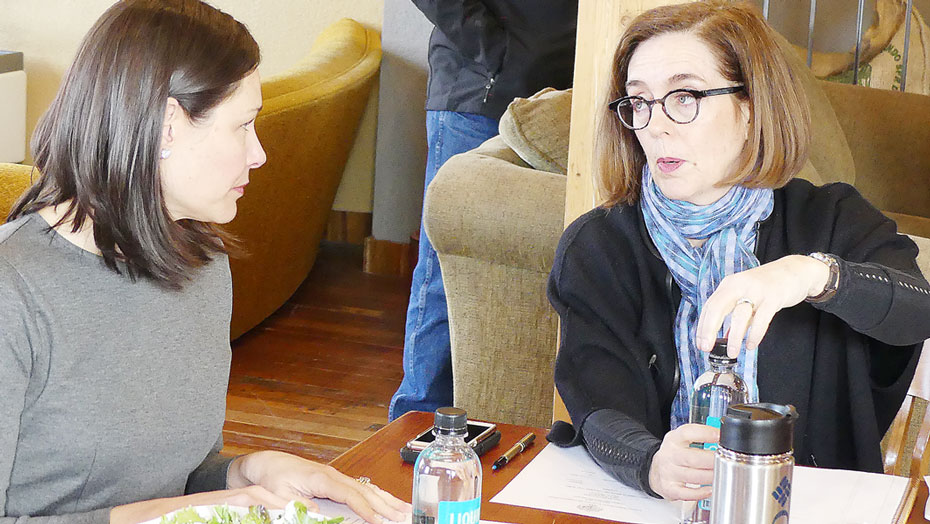
Shawna Peterson, (left) the chair of the Eastern Oregon Border Economic Development Board, chats with Gov. Kate Brown earlier this spring in Ontario. Peterson lauded the progress of HB 2456, a proposal to allow modest housing development in Malheur County. (The Enterprise/File).
ONTARIO – A proposal to change the land use rules in Malheur County remains in play at the Oregon Legislature after the House approved it earlier this month.
The proposed law – HB 2456 – is seen as the foundation of the legislative effort by the Eastern Oregon Border Economic Development Board, a seven-member committee of local people. The board is designed to spark job growth and economic development along the border with Idaho in Malheur County.
The proposed bill aims to open inferior agriculture land now zoned exclusively for farming to residential development.
The proposal paves the way to allow one “residential unit per lot or parcel of two acres or more.”
The legislation also specifies that no more than 200 acres can be rezoned by the county. That means no more than 100 new homes on rezoned land.
The bill cleared the House on a 37-20 vote and is now before the Senate Committee on Finance and Revenue.
State Rep. Lynn Findley, R-Vale, who sponsored the bill, said the political road for HB 2456 was difficult.
“It had some pretty hard opposition,” said Findley.
Findley said the bill faced resistance from land use groups such as 1,000 Friends of Oregon and the Oregon League of Women Voters and the Oregon Farm Bureau.
“I tried to explain to them it was a pretty unique situation. I started to think it wouldn’t get through. It died three times in committee and I was able to resuscitate it,” said Findley.
The bill met opposition from local farm bureau members, said Shawna Peterson, border board chair. That opposition in turn compelled the state farm bureau to stand against the idea.
Peterson said the border board reached out to local farm bureau members, provided information and sought input. Eventually, she said, the Oregon Farm Bureau adopted a neutral stance on the bill. That action by the bureau proved to be key, said Peterson.
“We like Oregon’s land use laws but it doesn’t fit here. So, we figured out a way to protect agriculture ground to make sure it wasn’t growth at any cost,” said Peterson.
The bill contains a number of land use safeguards to shield high-value farmland, including an amendment stipulating the rezoned property has not been farmed for three years. The rezoned land also cannot contain Class I, II or II soils.
The bill also protects “accepted farm or forest use practices on surrounding lands.”
The bill also creates a local four-person oversight board to review any land use change request. The board would consist of a member of the border board, the Malheur County Court, a farmer and someone from the Malheur County Planning Commission. The review board would hold at least one public hearing on any rezone application.
“So, there are many controls in place,” said Peterson.
News tip? Reporter Pat Caldwell: [email protected] or 541-473-3377.
For the latest news, follow the Enterprise on Facebook and Twitter.
SUBSCRIBE TO UNDERWRITE VITAL REPORTING — The Malheur Enterprise increasingly relies on reader subscriptions to fund its operations. For $5 a month, you get breaking news alerts, emailed newsletters and around-the-clock access to our stories. We depend on subscribers to pay for in-depth, accurate news produced by a professional and highly trained staff. Help us grow and get better with your subscription. Sign up HERE.




